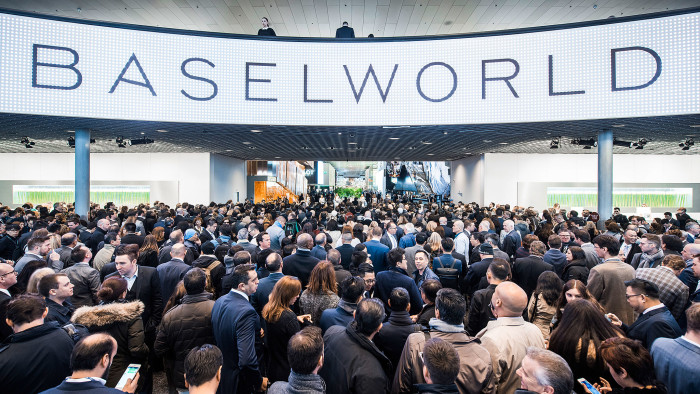Baselworld watch fair opens with brands cautious and critical

Roula Khalaf, Editor of the FT, selects her favourite stories in this weekly newsletter.
This year marks the centenary of a handful of Swiss watchmakers organising an exhibition of their latest creations. It was the foundation of a trade show that has grown into Baselworld, the largest and most important gathering in the horological calendar. Last year it attracted more than 145,000 people from more than 100 countries.
The 2017 event, which opens today, features around 300 watch brands unveiling new models, ranging from grand names such as Rolex, Patek Philippe, Omega and TAG Heuer to low-volume independents offering high-priced pieces for connoisseurs. But while the default Baselworld mood is upbeat, exhibitors and retailers will set out their stalls at this year’s show after a further decline in sales.
The January figures from the Federation of the Swiss Watch Industry show exports were down 6.2 per cent by value on the same month last year. Sales of precious metal watches fell 9.7 per cent, while those for steel models fell 0.8 per cent. This follows two full years of declining sales, including a contraction of almost 10 per cent last year.
Like many people in his position, Jean-Paul Girardin, the vice-president of Breitling, sees Baselworld as the most important opportunity of the year to sell watches and to cement client relationships — but he is not overly optimistic about how the fair will go. “The picture certainly looks interesting,” he says delicately. “While we must be confident, we also remain cautious. Although the industry has seen a general decline, our 2016 levels were around the same as those for 2015, and I think this can partly be attributed to the fact that we have never been very strong in China, so the market slowdown in that part of the world did not really affect us.”
He adds: “We also use a very high-tech system to monitor sales to ensure we don’t ship further stock before existing watches have been sold. This is in order to prevent an excess of product which could, potentially, lead to discounting and selling on the “grey market” (outside the intended region).
He believes, however, that sales success in the current retail environment will not come from offering cheaper products, but from maintaining the parity between price and quality. Breitling’s main Baselworld launch will be the Navitimer Rattrapante (£9,720), the first time the split seconds function has appeared on the Navitimer chronograph since its launch in 1952.
Hermès Watches, meanwhile, aims for a less technically-focused sector of the market with its range of dress and sports pieces, including longstanding favourites such as the Cape Cod. This, says chief executive Laurent Dordet, is exactly the sort of well-recognised model that can help to support a brand in tricky times. “Within a difficult and highly unstable economic context, we see a comeback to more classical watches instead of over-designed timepieces,” he says.
Mr Dordet believes that, despite general instability in the industry, the watchmaking side of the Hermès business is in a relatively good position because it creates up to 95 per cent of its products in-house, following a decade-long programme of integration. The company produces its own dials, cases, movements and straps.
Baselworld attendees can visit the maison’s stand on the first floor of Hall 1, but the prospect of setting up in such a prestigious location is beyond many smaller independent brands because of the cost of space. This causes them to “piggyback” on the main event by holding meetings in nearby hotel suites.
One brand that does this is H Moser & Co, a small-volume producer of simple but high-end watches that exhibits both at January’s SIHH watch show, populated by luxury conglomerate Richemont’s brands, in Geneva, and at the Ramada Hotel in Basel during Baselworld.
Edouard Meylan, chief executive of H Moser, says: “A small brand such as ours simply doesn’t have the budget to show in the main halls at Baselworld, which charges around SFr1,500 ($1,490) per square metre of space.
“On top of that, you have to pay to construct the stand and then you have to do absolutely everything else yourself. Our suite at the Ramada Hotel covers 250 sq m and costs a fraction of the price of being an official Baselworld exhibitor, and we have reduced costs further by sharing the space with some other brands.”
The gap between the fairs is philosophical as well as geographical, continues Mr Meylan. “The SIHH is run as a college, with everyone working together and being included in the decision-making process. At Baselworld, no one asks.
“The attitude is that the exhibitors should be grateful just to be there.”
Those smaller brands which can afford to show at Baselworld have a new space this year. The organisers have removed the marquee known as the Palace, because around 30 independent brands which used to show in it are no longer attending, and have replaced it with a set-up on the first floor of Hall 1, dubbed Les Ateliers.
Yvan Arpa, owner of self-described “provocative” niche brand ArtyA, has moved into Les Ateliers this year: “The space is far better than before, but it does require each brand to build its own booth from scratch, which has cost us SFr50,000-SFr60,000 on top of the cost of renting the space. But the show remains the most important in the world and, if you can afford to be there, you have to go.”
The Financial Times asked Baselworld’s managing director, Sylvie Ritter, for comment about these changes but she was unavailable.
Comments